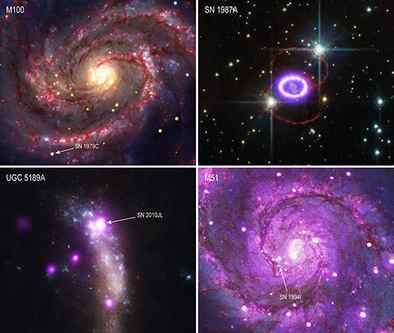Star clusters contain hundreds of stars that formed at about the same time. In the youngest clusters, those less than a million years old, 80% or more of the stars show strong infrared light produced by warm disks. This percentage drops quickly as the cluster ages increase, which shows that the disks do not survive for more than a few million years. What’s left behind once they dissipate? Roughly 20% of stars similar to our Sun have observable dust at mid-infrared wavelengths, which is thought to be produced by collisions among icy and rocky bodies much like comets and asteroids. Astronomers regard these objects as the leftover materials of planet formation.
Stars
Our solar system consists of the Sun, whose gravity keeps everything from flying apart, eight planets, hundreds of moons, and billions of smaller bodies – from comets and asteroids to meteoroids and tiny bits of ice and rock. Similarly, exoplanetary systems are groups of non-stellar objects circling stars other than the Sun, and astronomers have found thousands of them.
Construction Zone
Construction Zone
The layout of our solar system provided the first clues for how planetary systems come to be. All of the planets circle the Sun in the same direction, and their orbits all lie in nearly the same plane. From this, early astronomers supposed that the Sun formed at the center of a large, flat cloud of gas and dust now called the solar nebula and that the planets formed farther out. This picture has been much refined, but it captures the essential idea – planetary systems are really a side effect of making stars.
Stars form inside vast, cold clouds of gas and dust, stellar factories called molecular clouds. They’re always in motion, and now and then part of a cloud begins to collapse in response to its own gravity. As gas falls toward the center, it heats up and rotates faster, flattening into a disk. The glowing central mass becomes a newborn star, while farther out in the disk solid particles of rock and ice collide and merge to build up ever-larger objects. This protoplanetary disk may extend more than 100 times Earth’s distance from the Sun.
Our solar system began to form about 4.6 billion years ago. Astronomers think small rocky and icy grains within the solar nebula began sticking together, growing into even larger objects. Although the process remains poorly understood, solid objects miles or more across eventually populated the disk. Astronomers call these bodies planetesimals. Within a million years after the proto-Sun formed, collisions among planetesimals created larger bodies called planetary embryos, which were roughly as massive as Mars. After another few million years, radiation from the young Sun and nearby stars dispersed the disk’s remaining gas, leaving behind only solid objects, which continued to collide, shatter, and merge to form the planets, asteroids, and other bodies we see today.

Detecting Disks
Detecting Disks
Astronomers now routinely observe disks around young stars, either by directly imaging them or by detecting extra light – more than the star alone could produce – emitted by the disk materials. Examples of directly imaged disks include those around the stars AU Microscopii and Beta Pictoris, which both also harbor at least two confirmed planets.
In our solar system, meteorites – space rocks that fall to Earth’s surface – and samples from space missions provide chemical, physical, and magnetic clues about the ancient solar nebula and how planet formation progressed within it.
New Stellar Danger to Planets Identified by NASA’s Chandra

Astronomers have determined supernova explosions pose yet another threat to planets and their atmospheres. This result comes from analysis of X-ray observations for over 30 supernovae using NASA’s Chandra X-ray Observatory and other telescopes.
Astronomers using data from NASA’s Chandra X-ray Observatory and other telescopes have identified a new threat to life on planets like Earth: a phase during which intense X-rays from exploded stars can affect planets over 100 light-years away. This result, as outlined in our latest press release, has implication for the study of exoplanets and their habitability.
This newly found threat comes from a supernova’s blast wave striking dense gas surrounding the exploded star, as depicted in the upper right of our artist’s impression. When this impact occurs it can produce a large dose of X-rays that reaches an Earth-like planet (shown in the lower left, illuminated by its host star out of view to the right) months to years after the explosion and may last for decades. Such intense exposure may trigger an extinction event on the planet.
A new study reporting this threat is based on X-ray observations of 31 supernovae and their aftermath — mostly from NASA’s Chandra X-ray Observatory, Swift and NuSTAR missions, and ESA’s XMM-Newton — show that planets can be subjected to lethal doses of radiation located as much as about 160 light-years away. Four of the supernovae in the study (SN 1979C, SN 1987A, SN 2010jl, and SN 1994I) are shown in composite images containing Chandra data in the supplemental image.

Prior to this, most research on the effects of supernova explosions had focused on the danger from two periods: the intense radiation produced by a supernova in the days and months after the explosion, and the energetic particles that arrive hundreds to thousands of years afterward.
If a torrent of X-rays sweeps over a nearby planet, the radiation could severely alter the planet’s atmospheric chemistry. For an Earth-like planet, this process could wipe out a significant portion of ozone, which ultimately protects life from the dangerous ultraviolet radiation of its host star. It could also lead to the demise of a wide range of organisms, especially marine ones at the foundation of the food chain, leading to an extinction event.
After years of lethal X-ray exposure from the supernova’s interaction, and the impact of ultraviolet radiation from an Earth-like planet’s host star, a large amount of nitrogen dioxide may be produced, causing a brown haze in the atmosphere, as shown in the illustration. A “de-greening” of land masses could also occur because of damage to plants.
A separate artist’s impression (panel #1) depicts the same Earth-like planet as having been abundant with life at the time of the nearby supernova, years before most of the X-ray’s impacts are felt (panel #2).

Among the four supernovae in the set of images, SN 2010jl has produced the most X-rays. The authors estimate it to have delivered a lethal dose of X-rays for Earth-like planets less than about 100 light-years away.
There is strong evidence — including the detection in different locations around the globe of a radioactive type of iron — that supernovae occurred close to Earth between about 2 million and 8 million years ago. Researchers estimate these supernovae were between about 65 and 500 light-years away from Earth.
Although the Earth and the Solar System are currently in a safe space in terms of potential supernova explosions, many other planets in the Milky Way are not. These high-energy events would effectively shrink the areas within the Milky Way galaxy, known as the Galactic Habitable Zone, where conditions would be conducive for life as we know it.
Because the X-ray observations of supernovae are sparse, particularly of the variety that strongly interact with their surroundings, the authors urge follow-up observations of interacting supernovae for months and years after the explosion.
The paper describing this result appears in the April 20, 2023 issue of The Astrophysical Journal, and is available here. The other authors of the paper are Ian Brunton, Connor O’Mahoney, and Brian Fields (University of Illinois at Urbana-Champaign), Adrian Melott (University of Kansas), and Brian Thomas (Washburn University in Kansas).
NASA’s Marshall Space Flight Center manages the Chandra program. The Smithsonian Astrophysical Observatory’s Chandra X-ray Center controls science operations from Cambridge, Massachusetts, and flight operations from Burlington, Massachusetts.
Image credit: Science: NASA/CXC/Univ. of Illinois/I. Brunton et al.; Illustration: NASA/CXC/M. Weiss
For more Chandra images, multimedia and related materials, visit:




